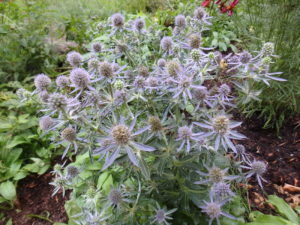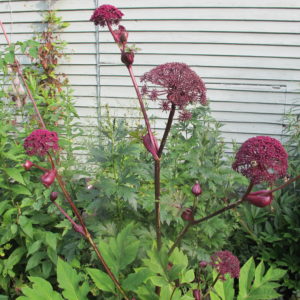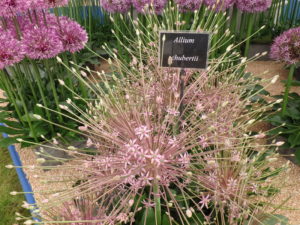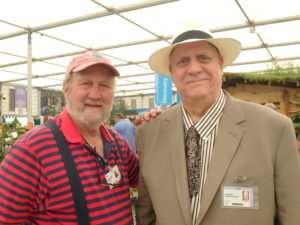End of Year Reflections
This was a good gardening year for me. Although we had some rainy times, and some hot, dry times, overall the weather was conducive to good plant growth. As usual, I tried a number of new things. Here are some of the things I tried this year.
In the vegetable garden I grew a new potato variety that I liked a lot called “Magic Molly”. It is sold by Fedco Seed Coop as a fingerling, but if you let them keep growing, the potatoes get to be quite large. I love the color: a purple so deep it is almost black when picked. It is dark colored inside and out, and keeps its color quite well when cooked, so it is good looking in a stew. Some purple potatoes turn gray when cooked, which is less appealing.
I tried a new (to me) tomato this year, a hybrid from Burpee Seed Company called Brandy Boy. I met the CEO of Burpee, George Ball, at the Chelsea Flower Show in London. He told me that Brandy Boy was earlier than Brandywine, my favorite heirloom tomato, and that it had disease resistance that heirlooms don’t have. He said that the flavor was comparable to Brandywine, and I agree. Very tasty.
In order to get Brandy Boy this year I had to buy plants from Burpee – I only learned about it in late May, much too late to start plants from seed. But I’m glad I did, it gave me a chance to try it this year. Next year I will plant seeds indoors in April, which is much more economical. I checked my local nurseries for plants last May, but no one had any.
Over the years my vegetable garden has gotten shadier and shadier. Now I don’t get direct sun until mid-morning, and it gets behind trees in late afternoon. So I get about 6 hours of prime sun, with sun filtered through trees at other times. I compared notes with other growers who get bigger yields, and know that sun is a major factor. I would cut down the offending trees, but most are on my neighbors’ property. Sigh.
I planted strawberries last summer, the first time in years. Strawberries are short-lived perennial plants – three years is about all one generally gets from a planting. The first year the plants will bloom, but growers advise picking off all the blossoms so that the roots and plants will develop better. I did that, and anticipate a good crop next June.
Most strawberries are sensitive to length of day, and produce heavy crops only in June. But now there are day-neutral plants, and everbearing plants that will produce some berries all summer and into the fall. This time I chose a June-bearing variety as there is a new insect pest, the spotted-winged drosophila that is mostly present late in the season. Hopefully this fruit fly won’t arrive until my crop has finished producing.
In the flower garden I tried a new biennial, angelica (Angelica archangelica) and was delighted with it. This is a tall plant that produces globes of deep purple florets in globes about two to three inches across. Not only is it gorgeous, it attracts bees like crazy.
Like all biennials, angelica only blooms at the end of its second year of growth, then dies. I planted some of the seeds this year, but if I want it to flower next year I will have to buy another plant, and this one cost even more than a perennial flower. That leads me to believe it is not an easy flower to grow.
I was delighted to see that I finally have the proper soil for my sea holly, also called Eryngium. Sea holly has wonderful bluish flowers with spiky appendages around the globe-shaped blossoms that resemble globe thistle.
I have tried numerous times to get the proper soil to accommodate its needs, and finally got it to over winter and flower in year two. It hates good rich soil, and will only overwinter in sandy, nutrient-poor soil. So I created a spot for it by digging up some driveway soil and replacing my good soil. Bingo. It worked.
This was a great year for daylilies, which continued to bloom through much of September, even varieties that are normally finished in mid-August. I have no idea why they bloomed for such a long period, but enjoyed the show. You may not think of daylilies as cut flowers, but a scape (stem) cut with multiple buds will continue to open the buds and bloom, day after day. Just place the vase where it gets some good direct sun each day.
I planted 2 woody plants this summer: a catalpa tree and a shrub called button bush (Cephalanthus occidentalis). The catalpa will be a large specimen tree on a section of lawn that I always left for badminton. Given how little I play, I gave the lawn over to a magnificent flowering tree. It is 10 feet tall, and will get to be 40 or so, blooming in late June and into July. It’s fragrant, too.
Button bush, a native plant, likes moist soil and sun to part shade. I have plenty of moist soil, so planted one near my brook. It produces neat, round white blossoms in early summer.
I wish you all a great gardening year for 2018. May your veggies produce well, your flowers surprise you, and the Japanese beetles fly past your roses and land next door.
Henry is a UNH Master Gardener and the author of 4 gardening books. His website is www.Gardening-Guy.com. Henry blogs at www.dailyuv.com.
The Chelsea Flower Show
It would be a bit of an exaggeration to say that I have always wanted to attend the Chelsea Flower Show in London. But not much. For years I’ve dreamed of going – and finally, this year, I went. Air ticket prices are down dramatically, the dollar is strong, and I decided there was no better time than now to cross off yet another item on my bucket list. It was well worth the effort.
Some basics: the Chelsea Flower Show is held on the grounds of the Chelsea Hospital in central London, which is now a retirement home for World War II soldiers. The show is bigger than anything in America: it encompasses 11 acres of displays, the vast majority of which are outdoors. That means that full-sized mature trees are installed, and in one case, a garden in a faux stone quarry was installed with blocks of stone stacked up more than 25 feet.
The show includes garden displays, rare plants, sculpture, food courts, vendors selling garden paraphernalia, music and much, much more. It has been an annual event since 1913 with the exception of a few years during the World Wars .
Tickets for next year’s show go on sale August 1, and although prices are not yet posted, tickets are not cheap – this year a full day ticket went for 100 pounds (($128). Each year the number of tickets is limited and they generally sell out before the event – this year some determined attendees apparently paid scalpers 500 pounds and more. It’s the Super Bowl of gardening.
If you want to go next year, the best plan is buy a membership to the Royal Horticultural Society, which allows you to attend a day before the doors open to the public, and offers discounted tickets.
I go to flower shows to learn. I delighted in seeing new (to me) species of flowers and new ways of combining flowers in the garden. I loved meeting garden experts and artists who created sculpture for the gardens.
So what are some of the things I learned? Thistles, which we generally consider weeds, can look great when planted in the garden. There I was in a city of millions, and a thistle, Cirsium rivulare ‘Atropurpureum’, was loaded with bees of all sorts! Clearly a great pollinator. Although a quick internet search did not lead me to seeds for that magenta-purple variety I saw there, I did find some seeds for a species native to the U.S. – Cirsium discolor – that is not the weedy pest farmers hate. So I shall order some seeds and try growing it.
Alliums were in all their glory at the show. Big, dramatic balls of flowers on 18- to 30-inch stems were used in many of the gardens. These are bulb plants in the onion family, and I have a few. I shall look for Allium schubertii which has an other-worldly pinkish flower head about 16 inches across. Another good one was just labeled with its variety name, ‘Powder Puff’.
Angelica (Angelica gigas) is another flower that was often used in the show. This is a 3- to 5-foot tall purple-leafed flower that I grew 25 years ago, but it is a biennial that does not come back after flowering, and I dropped it from my plant palette. But I have already purchased and planted one since returning from the Chelsea show. It can be very dramatic in the garden.
Ferns were used as filler in many of the gardens at Chelsea, and I shall try using them, too. Of course, their gardens only had to look good for 6 days, so ferns that spread, or get too tall, were not a problem, though they might be in my garden. I have a patch of Japanese Painted Fern (Athyrium niponicum) which is great in dry shade. But this summer I will investigate other ferns. Many nurseries sell them, but I admit I haven’t paid much attention to them.
Interesting people I met? George Ball, owner of Burpee Seeds was there. He is a highly knowledgeable (and opinionated) plantsman who is passionate about seeds. I was interested to learn from him that Melania Trump’s grandfather was a Slovenian onion breeder.
Mr. Ball pointed out that most vegetable seeds originally came from Europe, which is actually farther north than we are – and hence not good choices here. He believes that modern hybrids, not heirloom seeds originally from Europe, are best. And he told me that in a blind taste test, 4 of 5 times, Burpee’s hybrid ‘Brandy Boy’ beat the heirloom ‘Brandywine’, which is one of my favorites for flavor. I am trying it this year, since it ripens earlier, and produces more fruit, according to him. I’ll let you know how mine do in August.
At a reception on press day by David Austin Roses for a new rose named after actress Dame Judi Dench, who was there, I met the 91-year old founder of the company. I was able to thank him for all the beauty he has introduced to the world.
The English know how to throw a party – or have a flower show. Picnics with champagne were everywhere. Women were dressed in flowered clothes and elegant garden hats; men wore suits, even in the hot sun. Of course, everyone was very polite. And I got to check off another item on my bucket list.
Read Henry’s twice-weekly garden blog at https://dailyuv.com/








